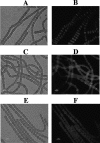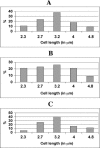Inhibition of cell division suppresses heterocyst development in Anabaena sp. strain PCC 7120
- PMID: 16452422
- PMCID: PMC1367218
- DOI: 10.1128/JB.188.4.1396-1404.2006
Inhibition of cell division suppresses heterocyst development in Anabaena sp. strain PCC 7120
Abstract
When the filamentous cyanobacterium Anabaena PCC 7120 is exposed to combined nitrogen starvation, 5 to 10% of the cells along each filament at semiregular intervals differentiate into heterocysts specialized in nitrogen fixation. Heterocysts are terminally differentiated cells in which the major cell division protein FtsZ is undetectable. In this report, we provide molecular evidence indicating that cell division is necessary for heterocyst development. FtsZ, which is translationally fused to the green fluorescent protein (GFP) as a reporter, is found to form a ring structure at the mid-cell position. SulA from Escherichia coli inhibits the GTPase activity of FtsZ in vitro and prevents the formation of FtsZ rings when expressed in Anabaena PCC 7120. The expression of sulA arrests cell division and suppresses heterocyst differentiation completely. The antibiotic aztreonam, which is targeted to the FtsI protein necessary for septum formation, has similar effects on both cell division and heterocyst differentiation, although in this case, the FtsZ ring is still formed. Therefore, heterocyst differentiation is coupled to cell division but independent of the formation of the FtsZ ring. Consistently, once the inhibitory pressure of cell division is removed, cell division should take place first before heterocyst differentiation resumes at a normal frequency. The arrest of cell division does not affect the accumulation of 2-oxoglutarate, which triggers heterocyst differentiation. Consistently, a nonmetabolizable analogue of 2-oxoglutarate does not rescue the failure of heterocyst differentiation when cell division is blocked. These results suggest that the control of heterocyst differentiation by cell division is independent of the 2-oxoglutarate signal.
Figures









Similar articles
-
An increase in the level of 2-oxoglutarate promotes heterocyst development in the cyanobacterium Anabaena sp. strain PCC 7120.Microbiology (Reading). 2003 Nov;149(Pt 11):3257-3263. doi: 10.1099/mic.0.26462-0. Microbiology (Reading). 2003. PMID: 14600238
-
Interactions of PatA with the Divisome during Heterocyst Differentiation in Anabaena.mSphere. 2020 May 20;5(3):e00188-20. doi: 10.1128/mSphere.00188-20. mSphere. 2020. PMID: 32434840 Free PMC article.
-
Septum-localized protein required for filament integrity and diazotrophy in the heterocyst-forming cyanobacterium Anabaena sp. strain PCC 7120.J Bacteriol. 2007 May;189(10):3884-90. doi: 10.1128/JB.00085-07. Epub 2007 Mar 16. J Bacteriol. 2007. PMID: 17369306 Free PMC article.
-
Heterocyst differentiation and pattern formation in cyanobacteria: a chorus of signals.Mol Microbiol. 2006 Jan;59(2):367-75. doi: 10.1111/j.1365-2958.2005.04979.x. Mol Microbiol. 2006. PMID: 16390435 Review.
-
Roles of DevBCA-like ABC transporters in the physiology of Anabaena sp. PCC 7120.Int J Med Microbiol. 2019 Jul;309(5):325-330. doi: 10.1016/j.ijmm.2019.04.005. Epub 2019 Apr 28. Int J Med Microbiol. 2019. PMID: 31133373 Review.
Cited by
-
Three-dimensional coordination of cell-division site positioning in a filamentous cyanobacterium.PNAS Nexus. 2022 Dec 24;2(2):pgac307. doi: 10.1093/pnasnexus/pgac307. eCollection 2023 Feb. PNAS Nexus. 2022. PMID: 36743469 Free PMC article.
-
Cyanobacterial heterocysts.Cold Spring Harb Perspect Biol. 2010 Apr;2(4):a000315. doi: 10.1101/cshperspect.a000315. Epub 2010 Feb 24. Cold Spring Harb Perspect Biol. 2010. PMID: 20452939 Free PMC article. Review.
-
A proteolytic pathway coordinates cell division and heterocyst differentiation in the cyanobacterium Anabaena sp. PCC 7120.Proc Natl Acad Sci U S A. 2022 Sep 6;119(36):e2207963119. doi: 10.1073/pnas.2207963119. Epub 2022 Aug 29. Proc Natl Acad Sci U S A. 2022. PMID: 36037363 Free PMC article.
-
Transcriptional regulation of the heterocyst patterning gene patA from Anabaena sp. strain PCC 7120.J Bacteriol. 2010 Sep;192(18):4732-40. doi: 10.1128/JB.00577-10. Epub 2010 Jul 9. J Bacteriol. 2010. PMID: 20622060 Free PMC article.
-
Diversity of Growth Patterns Probed in Live Cyanobacterial Cells Using a Fluorescent Analog of a Peptidoglycan Precursor.Front Microbiol. 2018 Apr 24;9:791. doi: 10.3389/fmicb.2018.00791. eCollection 2018. Front Microbiol. 2018. PMID: 29740419 Free PMC article.
References
-
- Adams, D. G., and N. G. Carr. 1981. Heterocyst differentiation and cell division in the cyanobacterium Anabaena cylindrica: effect of high light intensity. J. Cell Sci. 49:341-352. - PubMed
-
- Adams, D. G., and N. G. Carr. 1989. Control of heterocyst development in the cyanobacterium Anabaena cylindrica. J. Gen. Microbiol. 135:839-849.
-
- Beall, B., and J. Lutkenhaus. 1991. FtsZ in Bacillus subtilis is required for vegetative septation and for asymmetric septation during sporulation. Genes Dev. 5:447-455. - PubMed
Publication types
MeSH terms
Substances
LinkOut - more resources
Full Text Sources

